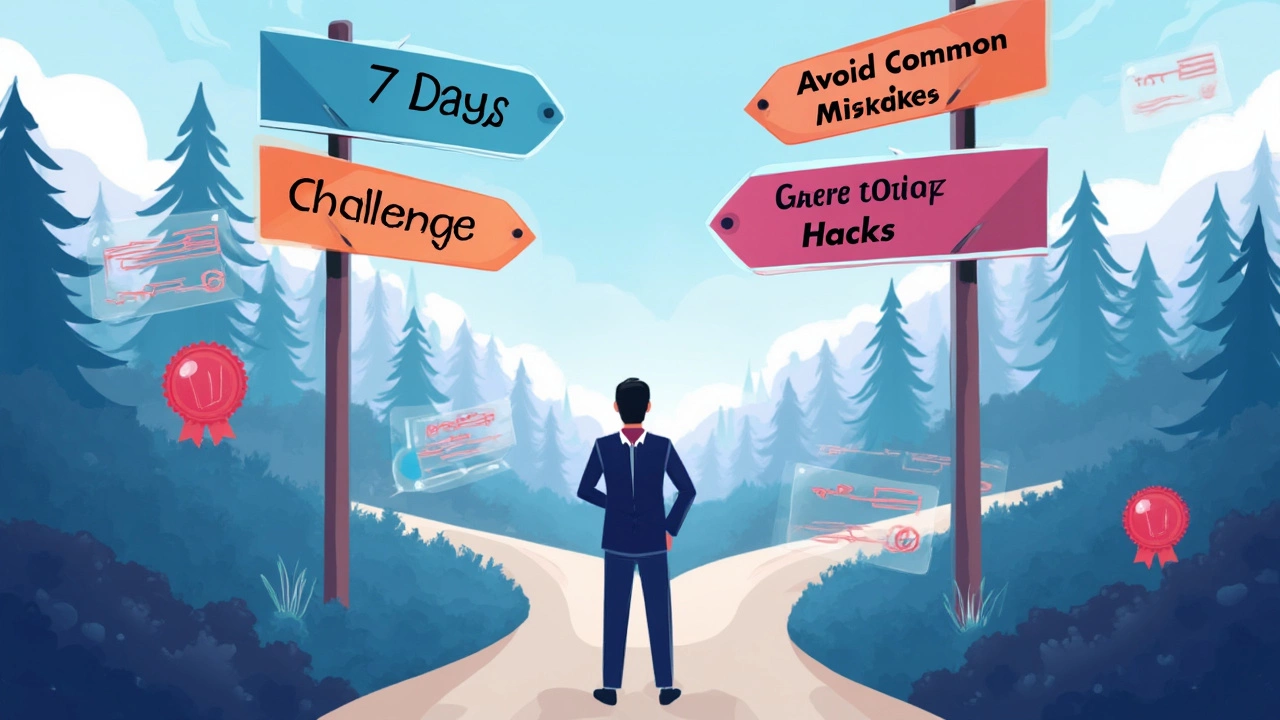Most people who sign up for the Google IT Certificate hear that it takes months—some say 3, others even 6. So why are folks obsessed with finishing it in a week? Honestly, time is money, and IT jobs are everywhere right now. If there’s a hack to land that line on your resume faster, people want it.
But is seven days actually doable, or is it just wishful thinking? Here’s the deal: the course is self-paced, entirely online, and split into five modules. Each module is stacked with video lectures, quizzes, and hands-on assignments. The official word on Coursera’s page says you’ll need ‘about six months at ten hours per week’—but let’s be real, not everyone goes at that pace.
Here’s where it gets interesting. You can technically binge it as hard and fast as you want. There are no drip-released lessons. No office-hour bottlenecks. Nothing is stopping you—except your own stamina and maybe your calendar.
Now, this isn’t just about speedrunning like some Netflix series. Sure, you can click ‘Next’ on every video, but there are graded quizzes and assignments that you’ll need to pass. If you just skim, you might miss easy points, get stuck on projects, or keep redoing assessments. Nothing’s more annoying than getting tripped up on mistakes you could have caught if you just paid a bit more attention.
- What’s Inside the Google IT Certificate?
- How Long Does It Really Take?
- 7-Day Game Plan: Is It Realistic?
- Time-Saving Tips and Study Strategies
- What Comes After the Certificate?
What’s Inside the Google IT Certificate?
This certificate is like your on-ramp to tech—no fancy degree or previous experience needed. The courses start you out with the basics and steadily ramp up the skills, so even if you’re totally new, you won’t feel lost. Here’s how it’s all laid out:
- Technical Support Fundamentals: Covers what IT support is, how computers work, and how the internet actually connects devices. You’ll get the basics down, like how operating systems talk to hardware.
- The Bits and Bytes of Computer Networking: Dives into networks—things like LANs, WANs, and what makes the internet tick. Expect hands-on work with network tools, plus the usual acronyms (TCP/IP, DNS, DHCP).
- Operating Systems and You: This course is all about running Windows and Linux, installing software, and digging into the command line for good measure.
- System Administration and IT Infrastructure Services: Think servers, cloud services, and keeping businesses’ IT infrastructure running behind the curtain.
- IT Security: Defense Against the Digital Dark Arts: You’ll see how to spot risks, avoid hacks, and understand basic cybersecurity like encryption and authentication.
Every module has a stack of video lectures, practical labs, quizzes, and graded assessments. Quizzes usually range from 7–20 questions and you need to score 80% or higher to pass. Labs use a real cloud-based environment, so you’re not just clicking buttons on a fake screen—you’re running real commands and fixing broken systems just like in a legit IT support role.
To give you a quick idea of what you’re working with, here’s a high-level breakdown:
| Course | Number of Videos | Labs | Estimated Hours |
|---|---|---|---|
| Technical Support Fundamentals | 87 | 7 | 19 |
| Computer Networking | 84 | 9 | 21 |
| Operating Systems | 84 | 13 | 23 |
| System Administration | 54 | 11 | 19 |
| IT Security | 46 | 8 | 15 |
So yeah, the Google IT Certificate gives you a whole tour of real-world tech support troubleshooting, networking, admin work, and cybersecurity. By the end, you’ll know what an IT job actually feels like from the inside out. That’s exactly why it’s become super popular with folks looking to break into tech fast.
How Long Does It Really Take?
Let’s get straight to the point: the Google IT Certificate is advertised as a self-paced course on Coursera. Officially, they say it takes around six months if you put in about 10 hours each week. That’s the standard answer, but it’s honestly just an estimate based on average users taking it slow and steady.
The whole thing is split across five key courses, packed with videos, practice quizzes, and hands-on labs. Some modules are lighter, while a couple pack real technical curveballs. If you already know a thing or two about computers—maybe you’ve troubleshot for family or you’re the go-to for ‘why won’t my Wi-Fi work’—you can skip through the easy stuff much faster. If you’re totally new, you’ll crawl a bit and need to google now and then.
Here’s a down-to-earth breakdown of what you’re up against if you treat it like a seven-day sprint:
| Course | Official Time Estimate | Realistic Daily Grind (7 Days) |
|---|---|---|
| Technical Support Fundamentals | 22 hours | 3 hours/day |
| The Bits and Bytes of Computer Networking | 24 hours | 3.5 hours/day |
| Operating Systems & You: Becoming a Power User | 19 hours | 2.5 hours/day |
| System Administration & IT Infrastructure Services | 21 hours | 3 hours/day |
| IT Security: Defense against the digital dark arts | 24 hours | 3.5 hours/day |
Add it up, and you’re looking at roughly 110 hours in total. Divide that by 7 days? That’s a brutal 15-16 hours every single day, with no days off, no real downtime, and probably way too much caffeine. Real talk: most folks just can’t power through like that—even college all-nighters don’t go on that long!
Some people do blast through it in a couple weeks, but they’re usually already tech-wizards, have the week off, or cut corners by fast-forwarding through content. If you’re new to IT or working a day job, trying to rush could leave you overwhelmed or burnt out. Plus, some practical assignments need manual reviews or system setup, so you can’t just speed-click the whole way.
So how long does it really take? If you stick to the pace of one course every day, be ready for brain overload and sore eyes. A more realistic quick finish is two or three weeks if you know your basics. For most regular folks, expect much closer to Coursera’s multi-week path unless you want to sacrifice sleep, sanity, or any chance of retaining what you learned.

7-Day Game Plan: Is It Realistic?
This is where things get serious. Can you really finish the Google IT Certificate in 7 days? The short answer: Yes, but it’s not exactly a casual walk in the park. Here’s what you’re up against: the course is laid out in five big modules (called "courses" on Coursera), and each has 15–30 hours of content if you watch and do every exercise in real time. Most people spread this out to keep their sanity.
If you crunch the numbers, you’re looking at around 120 hours for the full program. Cram that into a week and you need to hit about 17 hours per day—basically another full-time job. Check out how the math stacks up:
| Module | Estimated Hours |
|---|---|
| Technical Support Fundamentals | 20 |
| The Bits and Bytes of Computer Networking | 25 |
| Operating Systems and You | 25 |
| System Administration and IT Infrastructure Services | 25 |
| IT Security: Defense against the Digital Dark Arts | 25 |
| Total | 120 |
Some folks zip through by already knowing half the material or using the double-speed playback trick for the videos. If you have a tech background—maybe you’ve set up home networks, built PCs, or studied IT before—you’ll definitely blaze through the basics. But if you’re brand new, prepping for quizzes and hands-on stuff will slow you down. You can’t skip through the graded work either, since it triggers Coursera’s completion system.
So, what’s the real scoop? If you’re super motivated, have zero outside distractions, and don’t mind a massive week of screen time, it’s doable. Here’s a rough plan that shows just how packed your schedule might look:
- Day 1: Power through Module 1 (watch on 1.5x-2x speed, pause only to understand tricky points, finish exercises).
- Day 2: Tackle Module 2 (again, use speed tricks, get quizzes done, don’t skip labs).
- Days 3-6: Knock out Modules 3 and 4, splitting them over four days due to their chunkier hands-on sections.
- Day 7: Wrap up Module 5 and finish any missed quizzes or assignments.
If you burn out, you’ll feel it by day 3. Bring snacks, lots of water, and schedule micro-breaks. Some people pull it off, but you have to treat it like a high-intensity bootcamp, not a side hustle. For most folks, spreading it out over a couple of months keeps things sane and actually helps knowledge stick.
Time-Saving Tips and Study Strategies
If you’re eyeing a fast finish for the Google IT Certificate, you can’t just wing it. There are smart ways to cut wasted time and keep your head clear, even if you’re new to this kind of material. Here’s what works for real.
- Skip What You Know: The platform lets you jump ahead if you already understand certain videos or topics. Don’t sit through basic stuff you’ve done before—jump straight to the quizzes if you’re confident.
- Batch Assignments: Quizzes and short assignments are easy to batch. Do all the similar tasks in one go, so you get into a groove and finish faster.
- Use Community Forums: Thousands of learners have already done this certificate. If you hit a wall, don’t waste time guessing—hit the Coursera discussion threads and search for your problem. Chances are, someone’s already asked and solved it.
- Don’t Cram Everything Back-to-Back: If you grind for too long, your focus crashes. Work in blocks—like 50 minutes on, 10 minutes off. You’ll stay fresher that way.
- Take Smart Notes: Stop copy-pasting big chunks. Write quick bullet points of errors, command lines, or weird terms you see in labs. These often pop up in quizzes.
- Use Keyboard Shortcuts: Seriously, even shaving a few seconds each time you interact with the platform adds up over dozens of hours.
- Check Google’s Official FAQ: If you get stuck on technical issues or weird quiz errors, lots of time gets lost refreshing or panicking. Google has a help page just for Coursera users—bookmark it.
Let’s talk numbers. Here’s what learners report about their actual completion times for the certificate:
| Effort per Day | Days to Complete | Notes |
|---|---|---|
| 2 hours | ~90 | Most casual learners |
| 4 hours | ~45 | Full-time workers with evening study |
| 8+ hours | 7-10 | Super-intensive, rare but possible |
If you’re gunning for that 7-day badge, you’re basically looking at 8–10 hours a day. That pace is rough, but doable for short bursts. Expect the labs and troubleshooting practice to soak up most of your hours—don’t underestimate how many mistakes are just plain typos or missed steps. Double-check as you go.
Little hack: Always finish each session by previewing the next topic. You’ll prime your brain for what’s coming up and waste less time figuring out where you left off.

What Comes After the Certificate?
Finishing the Google IT Certificate feels great—but what does it really get you? Here’s where things get real: this certificate is actually recognized by big-name employers, especially in the U.S. Google, Walmart, and Hulu are just a few examples of companies that have either worked directly with the program or have hired folks with this credential on their resume. The certificate also gets you access to the Google Career Certificates Employer Consortium, which is a network of more than 150 companies.
The next step most people take is updating their resume and LinkedIn. Google even gives you template suggestions and instructions for adding the certificate so it stands out. It's honestly one of the easiest ways to prove you have hands-on skills without a four-year degree.
But don’t just stop there. A lot of certificate holders are able to step into jobs like IT support specialist, help desk tech, or junior sysadmin. In fact, Google’s own survey says that 75% of certificate graduates report a positive career impact (like a new job, promotion, or raise) within six months.
| Job Title | Typical Salary (USD) | Education Needed |
|---|---|---|
| IT Support Specialist | $55,000 | Certificate or Associate Degree |
| Help Desk Technician | $49,000 | Certificate or Associate Degree |
| Junior Systems Admin | $62,000 | Certificate or Associate Degree |
If you want to level up, you can use this certificate as a springboard for more advanced Google certificates (like Data Analytics or Cybersecurity), or even stack it with entry-level CompTIA certifications. Five years ago, breaking into IT took a lot of luck or a four-year degree. Now, this is a legit entry point with stats to back it up.
- Put your new skills to use on personal or volunteer tech projects—real experience means more than paper.
- Apply directly to jobs through Google’s consortium, or on regular job sites. Filter for “entry-level” IT roles.
- Keep learning. Tech changes fast, and more certificates or hands-on practice can open doors.
The goal isn’t just snagging a cert—it’s using it as a launchpad into your first real IT job. Stick with it, keep leveling up, and you’ll be surprised how fast your options multiply.

